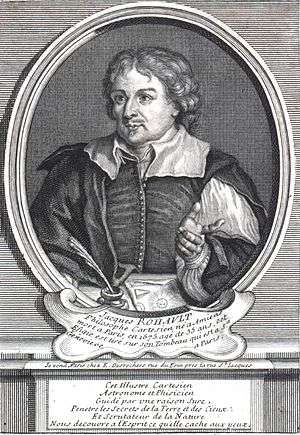Jacques Rohault

Jacques Rohault (French: [ʁɔ.o]; 1618–1672) was a French philosopher, physicist and mathematician, and a follower of Cartesianism.[1]
Life
Rohault was born in Amiens, the son of a wealthy wine merchant, and educated in Paris. Having grown up with the conventional scholastic philosophy of his day, he adopted and popularised the new Cartesian physics. His Wednesday lectures in Paris became celebrated; they began in the 1650s, and attracted in particular Pierre-Sylvain Régis.[2]
Rohault died on December 27, 1672 in Paris.
Works

Rohault held to the mechanical philosophy, and gave qualified support to its "corpuscular" or atomic form of explanation, assuming that "small figured bodies" were the underlying physical reality. His Traité de physique (Paris, 1671) became a standard textbook for half a century.[3][4] It followed the precedent set by Henricus Regius in separating physics from metaphysics.[5] It also included the theory of gravitation of Christiaan Huygens, given in terms of an experiment.[6] The translation of Samuel Clarke (initially into Latin) gained an independent status, and numerous editions, through its annotations that purported to correct it with reference to the theories of Isaac Newton. Rohault's experimental orientation remained popular, despite the criticisms of his theories.[3]
The Traité referred to a model of the eye that Rohault had worked on.[7] A wide range of experiments used by Rohault included some mentioned by Descartes, and two well-known ones of Blaise Pascal, but also others taken from medical men: Gaspard Asselli, Louis Gayant, William Harvey, Jean Pecquet, and Nicholas Steno.[8]
References
- ↑ Copleston, Frederick Charles (2003). A history of philosophy, Volume 4. Continuum International. p. 174. ISBN 978-0-8264-6898-7.
- ↑ Tad M. Schmaltz. Radical Cartesianism. Cambridge University Press. p. 7. ISBN 978-1-139-43425-6. Retrieved 29 May 2013.
- 1 2 Wilbur Applebaum (13 June 2000). Encyclopedia of the Scientific Revolution: From Copernicus to Newton. Routledge. p. 796. ISBN 978-1-135-58255-5. Retrieved 29 May 2013.
- ↑ Richard A. Watson (1998). The Breakdown of Cartesian Metaphysics. Hackett Publishing. p. 87. ISBN 978-0-87220-406-5. Retrieved 29 May 2013.
- ↑ R. Taton; C. Wilson; Michael Hoskin (18 September 2003). Planetary Astronomy from the Renaissance to the Rise of Astrophysics, Part A, Tycho Brahe to Newton. Cambridge University Press. p. 217. ISBN 978-0-521-54205-0. Retrieved 29 May 2013.
- ↑ John Andrew Schuster; Peter R.. Anstey (1 January 2005). Science of Nature in the Seventeenth Century: Patterns of Change in Early Modern Natural Philosophy. Springer. pp. 95–6. ISBN 978-1-4020-3703-0. Retrieved 29 May 2013.
- ↑ Nicholas Wade (2003). Destined for Distinguished Oblivion: The Scientific Vision of William Charles Wells (1757-1817). Springer. p. 36. ISBN 978-0-306-47385-2. Retrieved 29 May 2013.
- ↑ Stephen Gaukroger; John Schuster; John Sutton (1 November 2002). Descartes' Natural Philosophy. Taylor & Francis. p. 333. ISBN 978-0-203-46301-7. Retrieved 29 May 2013.